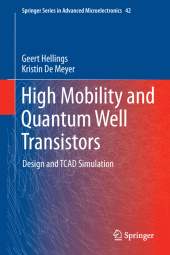 Neuerscheinungen 2015Stand: 2020-02-01 |
Schnellsuche
ISBN/Stichwort/Autor
|
Herderstra▀e 10
10625 Berlin
Tel.: 030 315 714 16
Fax 030 315 714 14
info@buchspektrum.de |

Kristin De Meyer, Geert Hellings
(Beteiligte)
High Mobility and Quantum Well Transistors
Design and TCAD Simulation
2013. 2015. xviii, 140 S. 15 Tabellen. 235 mm
Verlag/Jahr: SPRINGER NETHERLANDS; SPRINGER 2015
ISBN: 9400795696 (9400795696)
Neue ISBN: 978-9400795693 (9789400795693)
Preis und Lieferzeit: Bitte klicken
This book explores the use of high mobility semiconductors such as germanium and III-V materials, the need to redesign transistors to work with such materials and the appropriateness of Quantum Well-based transistors for this new stage of transistor evolution.
For many decades, the semiconductor industry has miniaturized transistors, delivering increased computing power to consumers at decreased cost. However, mere transistor downsizing does no longer provide the same improvements. One interesting option to further improve transistor characteristics is to use high mobility materials such as germanium and III-V materials. However, transistors have to be redesigned in order to fully benefit from these alternative materials.
High Mobility and Quantum Well Transistors: Design and TCAD Simulation investigates planar bulk Germanium pFET technology in chapters 2-4, focusing on both the fabrication of such a technology and on the process and electrical TCAD simulation. Furthermore, this book shows that Quantum Well based transistors can leverage the benefits of these alternative materials, since they confine the charge carriers to the high-mobility material using a heterostructure. The design and fabrication of one particular transistor structure - the SiGe Implant-Free Quantum Well pFET - is discussed. Electrical testing shows remarkable short-channel performance and prototypes are found to be competitive with a state-of-the-art planar strained-silicon technology. High mobility channels, providing high drive current, and heterostructure confinement, providing good short-channel control, make a promising combination for future technology nodes.
List of Abbreviations and Symbols.
1 Introduction. 1.1 Transistor Scaling. 1.2 What┤s Next? (2010 - ...). 1.3 Goals of the Book. 1.4 Organization of the Book.
2 S/D Junctions in Ge: experimental. 2.1 Introduction. 2.2 P-type Junctions. 2.3 N-Type Junctions. 2.4 Benchmarking. 2.5 Summary and Conclusions.
3 TCAD Simulation and Modeling of Ion Implants in Germanium. 3.1 Introduction. 3.2 Ion Implant into Germanium - Monte Carlo Simulations. 3.3 Ion Implant into Germanium - Analytical Description. 3.4 Application to a 70 nm Bulk Ge pFET Technology. 3.5 Summary and Conclusions.
4 Electrical TCAD Simulations and Modeling in Germanium. 4.1 Introduction. 4.2 TCAD Models for a Germanium pMOSFET technology. 4.3 Electrical TCAD simulations - 65 nm Ge pMOSFET Technology. 4.4 Impact of Interface Traps MOS Performance. 4.5 Summary and Conclusions.
5 Investigation of Quantum Well Transistors for Scaled Technologies. 5.1 Introduction. 5.2 Motivation - Scalability Issues in Bulk MOSFET Technologies. 5.3 Towards A Scalable Transistor Architecture. 5.4 High Electron Mobility Transistors: an Alternative Approach. 5.5 Operation of Heterostructure Transistors: Analytical Description. 5.6 Conclusions.
6 Implant-Free Quantum Well FETs: Experimental investigation. 6.1 Introduction. 6.2 First-Generation SiGe Implant-Free Quantum Well pFET. 6.3 Enhancing Performance in SiGe IFQW pFETs. 6.4 Second-generation Strained SiGe IFQW pFETs. 6.5 Matching Performance and VT -Tuning in IFQW pFETs. 6.6 SiGe Quantum Well Diffusion Study. 6.7 Conclusions.
7 Conclusions Future Work and Outlook. 7.1 Conclusions. 7.2 Future Work and Outlook.
Bibliography. List of Publications.


